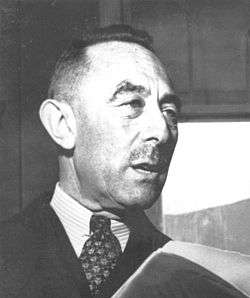Camille Gutt
| Camille Gutt | |
|---|---|
 Camille Gutt at the Bretton Woods Conference, 1944. | |
| 1st Managing Director of the IMF | |
|
In office 6 May 1946 – 5 May 1951 | |
| Preceded by | inaugural |
| Succeeded by | Ivar Rooth |
| Personal details | |
| Born |
Camille Guttenstein 14 November 1884 Brussels, Belgium |
| Died |
7 June 1971 (aged 86) Brussels, Belgium |
| Nationality |
|
| Alma mater | Université Libre de Bruxelles |
| Profession | Lawyer, economist |
Camille Gutt (14 November 1884 – 7 June 1971), born Camille Guttenstein, was a Belgian economist, politician, and industrialist. He served as the first Managing Director of the International Monetary Fund (IMF) from 6 May 1946 to 5 May 1951. Camille Gutt was the architect of a monetary reform plan that facilitated the recovery of the Belgian economy after World War II.
Early life
Born in Brussels, he was a son of Max Guttenstein and Marie-Paule Schweitzer. Max Guttenstein had moved to Belgium from Austria-Hungary in 1877 and became a Belgian citizen in 1886.[1][2] Camille Gutt attended high school at the Royal Athenaeum in Ixelles. Gutt obtained a Ph.D. in legal studies, and a master's degree in political and social sciences at the Université Libre de Bruxelles (ULB). During his study, he met Claire Frick, whom he married in 1906. The marriage gave birth to three sons: Jean-Max (1914-1941), François (1916–1944) and Etienne (1922–).[3]
Career
Camille Gutt worked in various industries, such as in the Société Générale de Belgique and Groupe Empain as well as politics. During World War I, Gutt worked for Georges Theunis and again from 1920 until 1924 as his Chief of Cabinet. Later, Gutt also worked for Emile Francqui. Camille Gutt was Minister of Finance of Belgium in 1934-1935 and 1939-1940, Minister of Finance, Economics and Traffic in 1940-1942, Minister of Finance and economics in 1942-1943, and Minister of Finance in 1943-1944 in the Belgian government in exile in London.
Gutt was responsible for saving the Belgian franc before and after World War II. Before the war, he saved the Belgian currency by secretly transferring the gold reserves of the Belgian National Bank out of Nazi reach. After the war, he stabilized the Belgian franc and forestalled inflation, with what still is known as the Gutt operation. Camille Gutt also played a major role in forging the Benelux, and by this contributed to the formation of the European Union.
Honours
.svg.png)


- Knight Grand Cross in the Order of Merit.

Selected publications
- ——— (1947), "The International Monetary Fund and Its Functions", Proceedings of the Academy of Political Science, 22 (2): 49–56, doi:10.2307/1173022 .
- ——— (1948), "Exchange Rates and the International Monetary Fund", Review of Economics and Statistics, 30 (2): 81–90, doi:10.2307/1928786 .
References
- ↑ Camille Gutt Archived 6 July 2011 at the Wayback Machine.
- ↑ An unusual postcard Archived 3 December 2008 at the Wayback Machine.
- ↑ Dictionnaire des femmes belges: XIXe et XXe siècles by Eliane Gubin; Lannoo Uitgeverij; 2006; p. 261-262
- ↑ Recueil Des Cours, Collected Courses, 1948, Volume 72.
Further reading
- Crombois, J.-F. (1999), "Camille Gutt et la création du Fonds monétaire international (1940-1946)", Relations Internationales (in French), 99: 289–305 (in French).
- Crombois, J.-F. (2000), Camille Gutt: Les finances et la guerre, 1940-1945 (in French), Gerpinnes: Quorum/Ceges-Soma, ISBN 2-87399-102-X (in French).
- Eichengreen, Barry J. (1995), "'Belgian miracle' to slow growth: the impact of the Marshall Plan and the European Payments Union", Europe's Post-War Recovery, New York: Cambridge University Press, pp. 271–291, ISBN 0-521-48279-8 .
External links
- IMF Archives
- United Nations Monetary and Financial Conference Final Act (Bretton Woods, New Hampshire July 1 to July 22, 1944)
- Newspaper clippings about Camille Gutt in the 20th Century Press Archives of the German National Library of Economics (ZBW)
| Civic offices | ||
|---|---|---|
| Preceded by inaugural |
Head of the International Monetary Fund 1946–1951 |
Succeeded by Ivar Rooth |